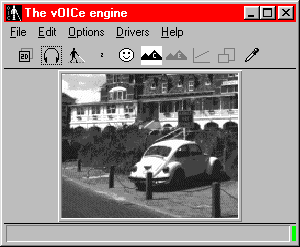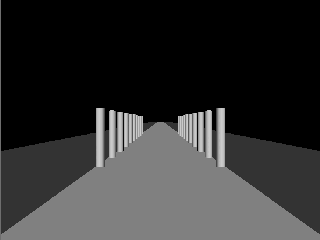
The following is a simple demonstration of what The vOICe for Windows can make of a long bright straight wall on your right side, containing a (darker) gate.

As you look along the wall with the camera, you hear a kind of smooth noise that widens its pitch range as you hear the sound scan move from left to right in full stereo. This widening is the effect of visual perspective: things that are nearby appear larger visually. So the parts of the wall that are closer appear larger in the soundscape. The bright wall visually widens toward the right, so that is what you hear: there is a direct correspondence between sight and sound in using The vOICe, as in using The vOICe for Windows with a webcam.
The sound of the wall is interrupted now for the directions corresponding to the gate in the wall. The wider the gate, the longer the interruption. The higher the gate, the greater the reduction in noise (pitch range). The gate is heard mainly in your right ear, because it is on your right in this example. Had it been on your left, you would have heard it mainly in your left ear.
 The vOICe for Windows |
In this particular view, you are perhaps still five or more yards away from the gate. With The vOICe, there is no distance limitation: you would have heard the gate from a fifty yards distance too if the gate is large enough. (Remember that visual objects appear smaller at a larger distance.)
Now if you were to make a few strides, the gate would sound larger, and you know from that how far away it is: if it had been very far off, no perceivable change in gate sound would have occurred. The closer it is, the larger the change in sound as you approach the gate.
So with The vOICe you hear that there is a gate, in what direction it is, what shape it has, and as you move around you can infer the actual size and distance of the gate. Any visual objects just become equivalent auditory objects.
Here a one-second soundscape was chosen, but with one button press (F3) one could have slowed down the soundscape to two seconds for inexperienced listeners. Experienced users would likely prefer one second or half a second per soundscape in mobile situations, or even a quarter of a second, depending also on walking speed. The vOICe for Windows is by default configured to provide up to eight soundscape scans per second. Notice that The vOICe mapping is open to conscious analysis. Once the concepts behind The vOICe mapping are understood, it becomes quite easy to predict what any given visual scene will approximately sound like.

|
Beware that Microsoft Windows Media Player 9 and 10 have the bad habit of
modifying (and resizing) local MP3 files upon playing them unless they are
first made read-only! Clearly it is generally unacceptable behaviour that
a media player changes the user's source media files, but the problem has
been ![]() confirmed by Microsoft.
confirmed by Microsoft.
Copyright © 1996 - 2024 Peter B.L. Meijer